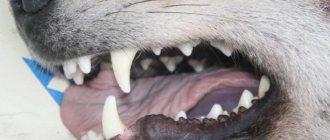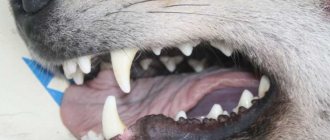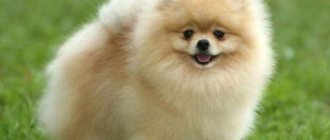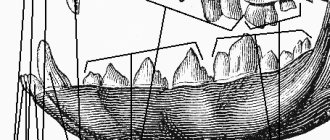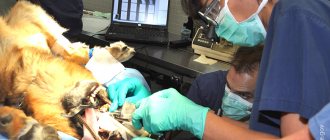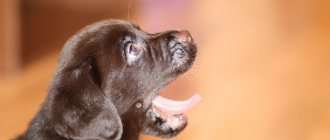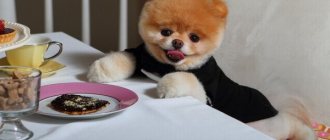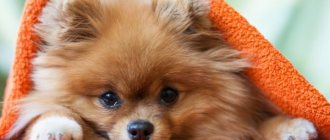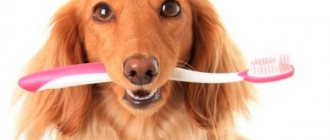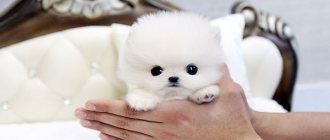Healthy and well-groomed teeth of a Spitz are always the merit of a caring owner. Most dogs undergo certification in kennels and clubs, during which competent specialists examine, including the puppy’s jaws.
But the impeccable results of the first test are far from a guarantee that after changing teeth, bite problems that are characteristic of small breeds will not arise. Monitoring the condition of your Spitz's teeth is important throughout the dog's life.
Pomeranian jaw anatomy
The dental system of the Pomeranian Spitz is formed gradually, going through the following stages:
- During the formation of the fetus in the womb, dentin is formed - hard dental tissue. But no bone formations are yet visible in the newborn puppy.
- The appearance of the first milk teeth. This is a temporary set of teeth that begins to emerge in the first month of a puppy’s life. Already on the 20-30th day, you can notice the first tiny teeth in the orange’s mouth - the incisors (front units). After the incisors, temporary fangs emerge, having the shape of a cone.
- When the Pomeranian is two months old, he, as a rule, has already formed a full-fledged milk supply of 28 units. The dental formula consists of two canines, six frontal units and twelve premolars (six on each jaw). When a dog closes its jaws, the upper row of teeth should normally cover the lower one. This is the so-called scissor bite, which is recognized as the standard for this breed.
- The final stage of the formation of the dental system is the change of teeth. Usually it is completed by ten months, but a slightly later end of the process is also not a pathology.
The process of changing teeth in German Spitz puppies during a normal course proceeds according to the following scheme:
- The permanent molar bud develops and grows under the root of the baby tooth.
- Due to the pressure of the growing bud, the temporary root begins to wobble and after a while falls out.
- Formed molars or incisors grow in the canal where the temporary tooth was previously located.
Helping dogs with the eruption of permanent teeth
To help puppies with problematic teeth and keep the furniture safe and sound, you need to take care of special toys in a timely manner. For example, these could be teethers; they are sold in any pet store. Or you can give the puppies a thick stick; they will happily chew on it and play with it.
To prevent gum inflammation, the owner needs to examine the mouth of his little four-legged friends every day. If during the examination problems were identified, for example, redness and bleeding of the gums, the appearance of an unpleasant odor from the mouth, discoloration of the teeth, then you should immediately show the animal to a doctor.
To reduce teething discomfort, you can give puppies tasty treats to chew on:
- bones or sticks;
- meat moslaki, boiled or raw cartilage;
- raw vegetables;
- dry wood from a fruit tree.
At what age do Pomeranians' teeth change?
There is no exact age at which Pomeranians begin to lose their baby teeth. In some puppies this happens earlier, in others, on the contrary, later. But if we take the average indicator, then the change of molars begins at the age of 12 to 14 weeks, completely ending by 10-11 months. The very first milk teeth erupt in the Pomeranian Spitz at 20-30 days from birth, and by two to three months after birth the dog already has a full set of milk teeth (28 units).
Upon completion of the change of teeth, the Pomeranian should have 42 permanent teeth, 20 of which are in the upper jaw, and 22 in the lower jaw.
How to get used to grooming
Dental examinations should be carried out on a regular basis and should begin at an early age. The main task of the owner is to accustom his pet to the fact that a dental check is a completely normal thing, and not stressful or an invasion of personal space. Therefore, the first examinations should be of a positive playful nature: give the puppy time so that he gets used to it and does not experience any unpleasant sensations. After which you can add a little cleaning.
The main means of caring for the dental system is brushing. This is an excellent preventive measure that helps prevent the formation of tartar. By regularly removing plaque, you will keep your Pomeranian's teeth in good shape and prevent tooth loss. You need to start at 3-4 months, don’t wait for a change, at 9 months it will be more difficult to train. Especially if the Pomeranian has an unpleasant experience after surgical removal of fangs. The first brushings should be purely symbolic; baby teeth will still fall out, but the puppy must get used to the fact that this is part of his life. Gradually increase the time, pay attention to hard-to-reach places, get to the premolars and molars.
Don't follow your dog's lead; there is hardly a single pet that likes brushing its teeth. But it is quite possible to train a Spitz to patiently endure the procedure. Otherwise, a simple yellow plaque will turn into stone, inflammation will begin and the dog will lose its teeth. The breed already has great difficulty in maintaining the kit at least by 6 years. Good nutrition, regular check-ups and preventive cleanings will help eliminate unpleasant odors, prolong the life of your teeth and save you from debilitating treatment for complications.
The order of teeth changing in oranges
Changing teeth is a gradual and unhurried process. The first to fall out are the primary incisors, which are located on the lower jaw. Since they do not have a strong root, they fall out quite easily. The upper primary incisors sit tighter. And very often the permanent molars begin to break through even before the milk teeth fall out.
At about six months, the Pomeranian's molars begin to erupt. Then the primary canines are replaced by permanent premolars.
Change of dentition by month
A Spitz's teeth change from 4.5 to 8 months. It is difficult to answer exactly what time the process will begin.
| Teething time in weeks | ||
| Name | Milk product | Constant |
| Incisors | 2-3 | 3-5 |
| Fangs | 3-5 | 6-7 |
| Premolars | 4-5 | 6-7 |
| Molars | — | 6-7 |
Permanent blocks are not cut all at once, but sequentially:
- The front ones are changed first - 6 on top and 6 on the bottom.
The two central incisors are called hooks, with the middle incisors on either side of them, hence the edges. The purpose of the front blocks is to chew small pieces of meat from the bone and take care of itself.
At the age of 3-5 months, the Spitz loses the anterior milk units of the lower jaw. The process is quick and easy, since the incisors do not have strong roots.
With older people the situation is more complicated. Often the root incisors begin to erupt before the milk comes out. The latter sits firmly, so the second row ends up in the first row. Therefore, in order not to spoil the bite and harm the dog, the temporary incisors are removed.
- After about six months, the cone-shaped units are replaced by Spitz.
Their purpose is to defend/attack and chop large chunks of meat. In almost 99% of cases, the dogs are taken by a veterinarian. If you shake them well, then without anesthesia; if not, then removal is carried out under general anesthesia.
The fangs cannot be left, as they will cause an incorrect bite and may deform the jaw. If permanent cone-shaped units are growing along with milk units, do not wait until the situation is resolved. When the upper canines grow to the size of baby teeth, they are removed. The lower ones shrink when they grow in the center of the milk.
- The last teeth to emerge are the premolars and molars.
Premolars (8 at the top and the same number at the bottom) and molars (5 on each jaw) do not have milk predecessors. They appear during the period of milk line change after six months. With their help, the dog chews and grinds food.
According to the standard, Spitz dogs have permanent units - 42 pieces. (more details on the lower jaw - 22, on the upper jaw - 20).
| Incisors | Fangs | Premolars | Molars | General |
| 12 | 4 | 16 | 10 | 42 |
The teeth necessarily include 6 front blocks at the bottom and top. However, the Spitz breed standard allows for the absence of several premolars.
All teeth should be white, without yellowing, enamel wear or wear.
When is a puppy's baby teeth removed?
Surgical intervention is required for Pomeranians whose permanent molars have already erupted and their baby teeth have not yet fallen out. Because of this, a dog sometimes develops double teeth in its mouth. But it is allowed to remove primary molars if two conditions are met:
- A baby temporary tooth can be removed only if a molar has already grown next to it. Otherwise, during removal, the rudiment of a permanent canine or incisor may be damaged, which will prevent it from growing.
- All baby teeth must be removed before nine months of age. Later removal will not help restore the bite.
Help at home
Each dog has its own development speed, so there is no need to rush the change of canines and incisors. During this period, the main thing is to do no harm:
- Do not entertain your pet with tug-of-war games or let him hang on various objects. The jaw is easily deformed, which leads to malocclusion.
- To loosen the milk units, you can give toys-bones made of leather or sinew, unsweetened crackers or whole carrots.
- Pomeranians need to eat properly. With a natural diet, mineral supplements with calcium and vitamins are required. Dairy products are included in the diet as a source of calcium.
From childhood, a puppy must be taught oral hygiene to prevent the formation of plaque, which can cause tooth loss and gum disease.
Bite: correct and abnormal
The correctness of the bite is established even before the moment of changing the dentition from temporary to permanent. Therefore, the bite of an orange can not be changed after a year. Normal and consistent with the breed standard is a scissor bite, in which the upper dentition covers the lower one.
An abnormal bite is a dental system formed with deviations from the norm. Thus, anomalies in the development of the dentition are:
- The presence of additional front blocks.
- Overlap. This is a phenomenon where there are empty spaces when the jaw is closed. In this case, the cone-shaped lower molars rest against the palate.
- Prognathism. A phenomenon in which the incisors on the lower jaw protrude more forward than the front ones.
- Claw bite. Characterized by the fact that the upper and lower row of teeth are in contact with the edges of each other.
- Displacement of dental units.
- Incomplete dentition. To understand whether there are any rudiments of molars at all, the dog is given an x-ray. If rudiments are found, the veterinarian, under anesthesia, will make incisions in the gums to facilitate their eruption.
If the malocclusion is acquired (i.e., caused by improper care of the dog), then it can still be corrected. Several leash techniques have been developed to correct the bite of Pomeranians. For example, forcing a four-legged friend to pull on a belt that is attached to the upper or lower canines (depending on whether the dog is undershot or overshot).
The danger of malocclusion
A bite that requires correction is a matter of both aesthetics and health. Due to dental diseases, which are a consequence, internal organs and the oral mucosa suffer, and sinusitis may develop.
It is especially important to have a good bite for animals that attend exhibitions and are involved in breeding work. The anomaly can be inherited, and such offspring will not have the required value.
Why does the bite develop incorrectly?
- hereditary factor;
- disturbed sequence of tooth changes;
- injuries;
- lack of minerals in the diet;
- “overload” of growing teeth;
- excessively large molars.
You can detect a malocclusion in a dog that has reached a certain age. As a rule, the owner notices pathology in the puppy’s jaws after four months. You should immediately begin to correct the bite before it is too late. In dogs after a year, it is much more difficult to achieve the desired result due to the compaction of the jaw bones and overgrown molars.
Tips for caring and cleaning the teeth of Pomeranians
Since dental care begins at a young age, you need to teach your Pomeranian to brush its teeth. It is recommended to carry out the very first procedures in a playful manner and in a relaxed atmosphere. It is impossible for the baby to form a negative association.
You need to care for both primary and permanent molars. Otherwise, the accumulated plaque will cause the development of caries and inflammation of the gums, making future changes difficult. Pomeranians are allowed to brush their teeth from three months of age. It is easier to train a Pomeranian to do this at a young age than at 8 or 9 months.
For cleaning you will need a special dog paste (it is completely harmless and it is not forbidden to swallow it) and a small brush for decorative dog breeds. Even an ordinary human brush will do for children. Cleaning is carried out once or twice a week.
If your dog has inflammation on his gums, then you need to take your Pomeranian to the veterinarian. Self-treatment of oral diseases is unacceptable.
Dental problems: what are they?
Here are some complications that can be associated with tooth replacement:
- Incorrectly growing fangs - unfortunately, they are fraught not only with a ban on visiting exhibitions. A Spitz can injure his tongue, palate, or lips with them. Ulcers will be stable formations in such a dog. She will, of course, be uncomfortable, including eating. In this case, either getting rid of baby teeth yourself on time or visiting a veterinarian will help.
- Second row of teeth - this happens when the molars are already actively growing, and the milk teeth do not even think about falling out. And, of course, a double row is not the norm; baby teeth from it must be promptly removed.
- The absence of some teeth is, as I wrote earlier, the norm, but not always. And in order to understand whether this is the norm in this particular case or not, it is worth visiting a veterinarian. He will order an x-ray, on the basis of which he will make a verdict. It may be that the molars cannot break through - in this case, you will need to make a careful incision in the gums.
- Inflammation of the gums - as I already wrote, it happens in cases where a baby tooth lingers in its place. But there is also a slight inflammation, which is even natural. In any case, it is important that the pet receives a balanced diet during this period and strengthens its immunity. Otherwise, any – even natural – slight inflammation will lead to the proliferation of harmful microflora.
- Poor appetite – I should note that this is often the case. Very often, a puppy rarely wants to eat during the period of teeth change. You can then try feeding him food that has the consistency of puree. You can even use a syringe for this purpose.
- Diarrhea - not everyone knows, but it also often accompanies a puppy during the period of teeth change. The fact is that this period is often associated with a decrease in immunity. And reduced immunity provokes the active development of various microorganisms in the intestines. Hence the diarrhea. However, you should not take it as something natural! After all, it is fraught with dehydration. To avoid dehydration, your dog should definitely be given enzymes, probiotics and rice water.
A beautiful and healthy pet is not only about genetics. In many ways, I must note, this is also the competent care of the owner. And dental care is an important component of such care. After all, with bad teeth, a Pomeranian Spitz can easily develop problems with the digestive tract, heart, skin and respiratory organs.
Number of teeth by breed
The number of teeth may vary between breeds. Large dogs such as Labrador, German Shepherd or Rottweiler should have 42 teeth in their mouth. Deviation from standards is considered a vice.
In medium and small breeds, the number of teeth can range from 36 to 40. Sometimes there are individuals with 42 teeth in the mouth among spaniels and dachshunds, which are among the most common representatives of medium and small dogs. It will not be possible to find a terrier with so many teeth due to the fact that as a result of the selection of this breed, the structure of the jaws of such a dog has significantly changed, as a result of which the intercanine space has narrowed.
Here is a table of the number of teeth by breed:
| Breed | Number of teeth |
| Yorkshire Terrier | 40 |
| Chihuahua | 38-40 |
| Toy Terrier | 40 |
| German Shepherd | 42 |
| Retriever and Labrador | 42 |
| Pug | 38-40 |
| French Bulldog | 40 |
| Welsh Corgi | 38-40 |
| Laika | 42 |
| Husky | 42 |
| Cocker Spaniel | 42 |
| Collie | 42 |
| Brussels griffin | 40 |
| Bloodhound | 42 |
| Irish black spaniel | 40-42 |
| Australian heeler | 42 |
| Collie | 42 |
| American Hairless Spaniel | 40 |
| Chinese Crested Dog | 40 |
| Shih Tzu | 38-40 |
| Bull Terrier | 40-42 |
| Doberman | 42 |
| English bulldog | 40-42 |
| Newfoundland | 42 |
| Miniature Pinscher | 38-40 |
| Cane Corso | 42 |
| Tibetan Terrier | 42 |
| Greater Swiss Mountain Dog | 42 |
| Dogue de Bordeaux | 42 |
| Toy poodle | 40 |
| Greyhound | 42 |
| Samoyed dog | 40-42 |
| Siberian Husky | 42 |
| Beagle | 40 |
| Pomeranian Spitz | 38-40 |
Diagnosis of anomalies
There are obvious cases, such as a pronounced diastema or torsion, you can notice them yourself when standing in front of a mirror. But there are also minor disorders that are no less dangerous to health, and only a specialized doctor can identify them.
Usually, hidden defects are easily recognized by a dentist - when he conducts a preventive examination, removes plaque or places a filling. Then he describes the problem and gives a referral to an orthodontist, who will determine how to straighten the jaw, bite, and a couple of adjacent teeth. To do this, a specialist will conduct a thorough examination of the patient’s mouth with a computed tomography or x-ray.
The anomaly can also occur during life, for example, after injury. Therefore, it makes sense to visit a doctor regularly, every six months, so that he either confirms that everything is in order, or promptly notices unwanted changes, which are easier to stop at the initial stage.
Causes of malocclusions
The most common cause of malocclusion, unfortunately, cannot be eliminated. This is a hereditary factor. The only way to prevent its spread to offspring is to deprive genetically inferior animals of permission to breed.
In addition, this pathology can also be acquired. It is most often caused by insufficient care of the puppy. There are several such factors:
- Repeated heavy loads on the teeth of a young animal during active games of tug are very unhelpful for him. You need to carefully control the force with which the puppy pulls the coveted toy.
- The consequences of trauma and damage to the jaws when chewing bones and hard objects often lead to malocclusion.
- Violation of the timing of the loss of milk teeth leads to the fact that the growing molars, bumping into the missing milk teeth, change their direction of growth.
- Lack of calcium, vitamin D, and an unbalanced diet lead to rickets and gradually deform the bite.
- Abnormally short labial frenulums cause the teeth to be compressed, causing the bite to become pathological.
How to solve a problem
Acquired malocclusions can be corrected. This is not a task for one week or even a year, but the efforts will be generously rewarded. Upon completion of treatment, the dog will be able to take part in exhibitions and will be allowed to breed.
But even if the owner does not have the goal of pursuing a show career, it is necessary to treat his pet’s pathological bite. This is the key to his health and full life. It is better to do this when the puppy is not yet a year old.
Let's look at how to correct a dog's bite. This can be done in several ways, namely:
- removable devices;
- non-removable structures.
Removable devices
These include the so-called transparent removable aligners. They are placed over the teeth and should be worn at all times except when eating and brushing teeth. Their effect is constant and fairly strong pressure on the teeth in the desired direction. Every few months the design is replaced with a new one. It exerts stronger pressure, under the influence of which the teeth take the right direction. The orthodontic veterinarian must monitor the treatment process.
Removable braces can be used for puppies. They are shaped like a hard rubber ring. The principle of their action is the same, but they exert gentler pressure on the teeth.
Fixed structures
These are permanent braces. They are made of dense material and are firmly attached to the teeth using special dental glue. The force of their pressure is regulated using a special wire that connects the clasps that are put on the teeth. If necessary, the wire can be changed, thereby increasing or decreasing the pressure force.
Fixed structures have their contraindications. They cannot be installed if you have periodontal disease, stomatitis, or an allergic reaction to the braces material. Treatment is usually long-term.
Types of bites in dogs
- scissor-shaped
- pincer-shaped
- snack
- undershot
- A scissor bite is when the inner surface of the upper jaw overlaps slightly with the outer surface of the lower jaw. It is allowed for one canine or incisor to protrude from the row, which is not a malocclusion. A malocclusion is considered when the upper or lower teeth protrude completely, especially with the lower protrusion, possible health problems for the Spitz occur.
- Pincer bite (straight) - the incisors touch the edges. With this shape, the incisors grind down faster.
- Overshot (progenia) - when the lower incisors and canines are in front of the upper ones, but do not protrude beyond the upper lip.
- An undershot is an underdeveloped jaw, the lower part of which is much shorter than the upper. When the distance between the jaws is more than one centimeter, the fangs of the lower jaw injure the palate of the upper jaw. Underbite is a pathology. Stray dogs with this disease have no chance of surviving to adulthood.
An underbite can appear due to poor nutrition of the animal or infectious diseases during the period of renewal of the puppy's dentition. A slight underbite usually disappears on its own. Unless it's a genetic inheritance. Until the spitz's primary premolars and molars are replaced by permanent ones, there is no need to sound the alarm. If the palate is injured by fangs, you should show your pet to a veterinarian, and he will be able to painlessly shorten the problem incisors for the dog.
In order for a Spitz's bite to form without disturbances, you need to monitor the correct diet. Get all necessary vaccinations on time. And then the replacement process will go without complications.
Spitz dogs usually have a regular scissor bite.
For those who want to go further in correcting their pet's bite, you can contact an orthodontist who specializes in animals and get braces. Braces are special mechanisms that help straighten teeth and correct an animal’s malocclusion. There are removable and non-removable designs.
Why and when do you need to remove fangs?
It happens that the permanent teeth have come out, and some children’s fangs are still “sitting” in the Spitz’s mouth. The reason for this may be the fragile development of the chewing muscles, small gums, or feeding the puppy liquid food. If, for example, it is a child's lower canine, then the permanent lower canine has to grow on the inside of the lower jaw and its end usually grows incorrectly, causing pain when the animal eats.
A baby fang or incisor that barely holds on can be removed independently. It must be carefully loosened and pulled to the side, grasping it with a gauze napkin so as not to injure the dog’s gums. But deep-seated baby teeth cannot be pulled out, as fragments may remain in the gums.
But you shouldn’t leave them, as they can trap food and debris, distort your bite, and lead to early caries, tooth loss or gum disease. Removal of retained baby teeth is performed under general anesthesia by a veterinarian, no earlier than the puppy is 9 months old.
Signs of a missing baby tooth:
- Bad breath (halitosis)
- Incorrectly positioned molars
- Swollen, red, bleeding gums around baby teeth
- Gingivitis or periodontal disease
The primary canines of the lower jaw need to be removed only when the molars have grown by about half.
Of course, you shouldn’t neglect caring for your pet’s oral cavity. And you need to monitor his good condition. The dog needs to carry out hygiene 1-2 times a week, with a special soft brush for dogs and toothpaste or powder.
In order for a Spitz to change teeth without complications, this process must be constantly monitored until it is completely completed.
Many dogs do not like hygienic grazing procedures, but you can teach them to endure it patiently. Many Pomeranians lose their teeth after six years of life. And it is very important to preserve their teeth for as long as possible. An important preventative measure is to prevent the formation of tartar.
Mouth breathing
If you find that your child predominantly breathes through his mouth or snores at night, I advise you to immediately contact an ENT doctor first and foremost. Orthodontic measures for oral breathing in children can begin at 3-4 years of age. Mouth breathing in children leads to a violation of the position of the tongue: the tongue moves down the oral cavity and ceases to occupy the desired position. So it does not have a stimulating effect on the upper jaw - and it does not develop to the required extent. As a result, there is not enough space for permanent teeth, and they begin to grow unevenly. In addition, a narrow upper jaw can cause a habitual lateral displacement of the lower jaw. A crossbite and facial asymmetry will form. When dealing with mouth breathing, it is important to work in conjunction with an ENT doctor and often with a speech therapist. In some cases (for example, if the cause of mouth breathing is allergic rhinitis), we also involve an allergist. The task of the ENT doctor is to normalize the patency of the airways so that the child can physically breathe through the nose. Next, the orthodontist and speech therapist are included in the work. A speech therapist works with the muscles of the lips and tongue to train them and teach them to work normally. The orthodontist eliminates the effects of mouth breathing and can also prescribe myogymnastics - training for the muscles of the lips, cheeks, and tongue.
Why you need to straighten your teeth
Please note that the question is not whether it is worth correcting the bite - it simply needs to be done, and for several reasons:
- To avoid increased abrasion, caries, removal - when everything is normal, all incisors are evenly used when chewing, and in case of disturbances, some work more, others less; The former lose enamel faster and chip, the latter are less resistant to bacteria.
- To prevent diseases of the temporomandibular joints as a result of their mutual displacement. This pathology is also unpleasant due to bruxism, muscle spasms, clicking and crunching.
- To protect the gums, tongue and inner cheeks from injury caused by out-turned or tilted incisors.
- In order to grind food well during eating, not to create additional stress on the gastrointestinal tract and not to provoke problems with stool, enterocolitis, gastritis.
- To prevent problems with ENT organs and breathing, eliminate the source of bacterial accumulation and not give a single chance to sore throat, sinusitis, and otitis media.
People who have experienced complexes about their chin and then decided to have surgery or wear braces can tell a lot about whether to correct their bite. After medical help, they are much more willing to show their smile when communicating.
